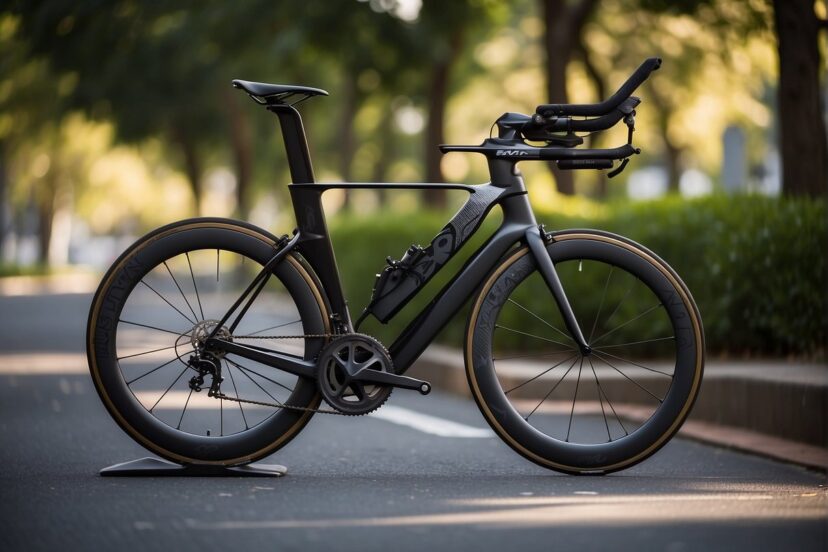Triathlon Bike: Racing Towards Victory
*We may earn a commission for purchases made using our links. Please see our disclosure to learn more.
Triathlon Bike Essentials: Choosing Your Competitive Edge
In my experience, a triathlon bike is crafted with a focus on performance and aerodynamics. When you’re competing in a triathlon, every second counts, and the design of your bike plays a critical role in your overall race time. A triathlon bike differs from a regular road bike in several ways. It’s designed for speed and efficiency over long distances. The frame geometry, for instance, is specifically tailored to help reduce wind resistance; this is where aerodynamics comes into play. The aggressive position it affords the rider optimizes power and minimizes air drag.
Fit and comfort are just as crucial as the aerodynamic profile of a triathlon bike. A poorly fitting bike can lead to discomfort and injuries, potentially impacting training and performance. Personalization of fit ensures that I can maintain the optimal position for power output and endurance, without sacrificing comfort during long races. With a well-fitted triathlon bike, I can ride for hours, minimizing fatigue and preserving energy for the running segment that follows the cycling one in a triathlon.
My understanding of the current market shows that bike manufacturers continue to innovate to improve the triathlon experience. The materials used in constructing triathlon bikes, such as carbon fiber, combine strength with lightweight properties, leading to faster and more responsive bikes. Advanced-grade composite materials and AeroSystem Shaping Technology, for instance, can dramatically reduce drag. These technologies exemplify how modern triathlon bikes enhance performance while also considering the rider’s need for a bike that’s reliable and comfortable throughout the entirety of the race.
Understanding Triathlon Bikes
Triathlon bikes are engineered for speed, efficiency, and optimal performance over long distances. I’ll guide you through the key features, materials, and design that define these specialized bikes.
Key Features
Triathlon bikes, or “tri bikes,” boast distinct aerodynamic features that differentiate them from standard road bikes. My focus is on a few crucial characteristics:
- Aero Bars: These are forward-reaching bars that allow me to tuck into an aerodynamic position, reducing wind resistance.
- Frame Design: The frames are often built with aero tubes, which are shaped to cut through the air more efficiently than standard round tubes.
- Integrated Storage: To maximize aerodynamics and convenience, storage for nutrition and tools is seamlessly integrated into the bike’s frame.
Frame Materials and Stiffness
The two primary materials used in triathlon bike frames are carbon and aluminum. Here’s how they compare:
- Carbon: This is the lighter and more prevalent option, prized for its stiffness-to-weight ratio. Carbon frames offer me superior vibration damping, leading to a more comfortable ride over long distances.
- Aluminum: A cost-effective alternative to carbon, aluminum frames are heavier but can still offer considerable stiffness.
Geometry and Bike Fit
The geometry of a triathlon bike is tailored to help maintain an aggressive riding position that maximizes aerodynamics and muscle efficiency. Here’s how:
- Seat Tube Angle: A steeper angle positions me further over the bottom bracket, which can enhance power transfer and reduce fatigue.
- Bike Fit: Personal body measurements are critical for selecting the right frame size and adjusting the bike components for my optimal fit. Adjustability in the saddle position and handlebar height are key factors for achieving this.
My understanding emphasizes the critical role that aerodynamics, comfort, adjustability, and frame materials play in the design and function of triathlon bikes. These elements are decisive in both performance output and overall riding experience.
Components and Technology

When examining triathlon bikes, I focus on pivotal components and technological advancements that refine performance. These facets are essential, dictating the efficiency, control, and overall speed a triathlete can harness during competition.
Drivetrain Innovations
My inspection of drivetrain advancements reveals a strong tilt toward electronic shifting systems, such as the Shimano Ultegra Di2 and SRAM eTap. Electronic shifting grants me the precision and reliability I seek, with swift, clean gear transitions that are less prone to human error compared to mechanical counterparts. Plus, there’s the added convenience of being able to shift gears from multiple positions on the bike.
Braking Systems
Next, I consider the braking system. Triathlon bikes have largely adopted disc brakes for their superior stopping power and modulation, especially under adverse weather conditions. Internal cable routing is often paired with these systems, not only to streamline the aesthetics but to reduce aerodynamic drag. This setup affords me both enhanced safety and a marginal gain in speed.
Cockpit and Aerobars
Finally, the cockpit and aerobars deserve attention. A well-engineered cockpit offers me vital control while optimizing my aerodynamic stance. I look for hydration solutions integrated within the cockpit area to maintain my aerodynamic form while staying hydrated. Aerobars, often featuring carbon construction, provide sturdy yet lightweight support, allowing me to maintain an aggressive, streamlined position for extended periods. Features like adjustability are key, ensuring a compatible fit with my body geometry for peak performance.
Integration for Performance
In modern triathlon bikes, the integration of components isn’t just about convenience—it’s a critical aspect of performance. From aerodynamics to on-bike nutrition, every design choice plays a role in shaving seconds off my time.
Aerodynamic Design and Storage
My triathlon bike’s design prioritizes aerodynamics to reduce drag. The frame features a streamlined shape and aerodynamic design innovations like fully integrated storage solutions. Storage doesn’t simply hold gear; it’s engineered to maintain the bike’s sleek profile.
For example, the Scott Plasma 6 hides cables and incorporates storage boxes that blend seamlessly with the frame. Similarly, bikes such as the Cervelo P-Series have integrated storage in the frame, which strategically positions equipment without disrupting air flow.
Hydration and Nutrition Systems
During races, I can’t afford to lose time fumbling for hydration or nutrition. That’s why integrated hydration systems are crucial. My bike includes an intuitively placed hydration system that allows me to drink without altering my aerodynamic position.
The integrated nutrition feature might be within the bike’s top tube, enabling me to access energy gels and bars swiftly. As I keep myself hydrated and fueled, these design elements ensure I maintain optimal performance throughout the race without compromising on speed or energy.
Selecting Your Triathlon Bike

When I look into selecting a triathlon bike, I focus on matching my performance needs with the ideal bike specifications. The goal is to find a bike that balances speed, comfort, and efficiency.
Considering Bike Brands and Models
In my search for the best triathlon bikes, I’ve noticed that several brands stand out due to their commitment to quality and performance. For instance, Canyon Speedmax and Quintana Roo offer advanced aerodynamic designs. The Felt IA 2.0 Disc is another model that catches my eye with its precision engineering. Trek’s Speed Concept SLR 7 is renowned for its integration of rider biomechanics with bike design.
Below is a quick list of notable triathlon bike models that have impressed me:
- Canyon Speedmax: Known for its exceptional aerodynamics.
- Quintana Roo PRfour Disc: Offers a balance of aerodynamics and adaptability.
- Felt IA 2.0 Disc: This bike stands out for its industry-leading components.
- Trek Speed Concept SLR 7: Excellent for its customizable options.
- Specialized S-Works Shiv Disc: Comes with an integrated hydration system.
- A2 Bikes SP1.2: Appeals for its affordability without compromising on performance.
- Ventum One: Unique for its non-traditional frame design.
- Argon 18 E-117 Tri Disc: A choice for those seeking a competitive edge.
- Diamondback Andean: Features that cater to speed and storage.
- BMC Timemachine: Renowned for its attention to time-trialling principles.
Remember, the key is to test various bikes to see which one feels right as each model will have its unique combination of features.
Importance of Local Recommendations
I strongly believe in the value of local recommendations. Talking to local triathletes and coaches has provided me insights that go beyond what I can read online or in magazines. Their experiences can inform me about how a bike performs in real-world conditions and guide me in selecting a size that best fits my body.
Here’s how I typically gather local opinions:
- Visit local bike shops: Engage with experienced staff who can give me firsthand advice.
- Join triathlon clubs or groups: They often have bike demo days where I can test different models.
- Local races: Observe which bike models are frequently used and inquire about their performance.
Local expertise can provide valuable, nuanced information that might not be accessible through general reviews and can affect my purchasing decision.
The Cost-Benefit Analysis of a Triathlon Bike

In this section, I’ll break down the financial aspects of triathlon bikes, focusing on the variation in prices and the corresponding value. I’ll help you understand how different bike tiers, from entry-level to high-performance models, stack up.
Triathlon Bike: Assessing Price and Value
For aspiring triathletes, price is a primary consideration when choosing a bike. I’ve noticed that entry-level models can be quite affordable, often priced below $1,000. These bikes typically feature basic components and aluminum frames, offering a good starting point without a significant financial burden. As we move up to mid-range models, priced between $1,000 and $5,000, the value proposition shifts. These bikes often come with carbon fiber components and more sophisticated designs, potentially offering a better balance of cost and performance.
On the higher end, premium triathlon bikes, which can cost several thousands of dollars, boast advanced aerodynamics and cutting-edge technology. The value here is perceived through marginal gains in speed and efficiency, which can be critical for competitive racers. Crucial to note is that the direct-to-consumer model is becoming more prevalent, allowing manufacturers to offer high-performance models at slightly reduced rates by bypassing traditional retail overheads. However, I must emphasize that while premium bikes may offer the best in performance, the actual improvement over more modestly priced models may only be significant for seasoned athletes looking to fine-tune their racing edge.
Comparing Entry-Level to High-Performance Models
When comparing entry-level and high-performance bikes, it’s clear that the cost difference can be substantial. Entry-level triathlon bikes are characterized by their more affordable price tag, often due to less expensive materials and components. These bikes make triathlon racing accessible to beginners and those on a tight budget, providing the bare essentials for the sport.
Conversely, high-performance models are engineered for maximum speed, efficiency, and rider comfort over long distances. These bikes use state-of-the-art materials like high-grade carbon composites and come equipped with top-tier components, such as electronic shifting and integrated storage. While they represent a significant investment, for competitive triathletes, every second shaved off a race can justify the cost.
Entry-Level Triathlon Bikes:
- Price Range: <$1,000
- Components: Basic, often aluminum frames
- Best for: Beginners or budget-conscious riders
Mid-Range Triathlon Bikes:
- Price Range: $1,000 – $5,000
- Components: Intermediate, often a mix of carbon and aluminum
- Best for: Amateur racers, those seeking a decent performance without splurging
High-Performance Triathlon Bikes:
- Price Range: >$5,000
- Components: High-end, predominantly carbon fiber
- Best for: Serious racers, those prioritizing performance at all costs
FAQs About Your Triathlon Bike

In this section, I’ll address some of the most common inquiries regarding triathlon bikes, from selecting the right model to understanding the specifics that differentiate them from traditional road bikes.
1. What should I look for when choosing a triathlon bike?
When choosing a triathlon bike, I prioritize components and technology that enhance aerodynamics and performance, alongside the fit and comfort that will support me through long races. Adjustability of aero bars and a suitable frame geometry are key for both comfort and speed.
2. How do triathlon bikes differ from traditional road bikes?
Triathlon bikes are designed with a focus on aerodynamics and efficiency in a straight-line position, often showcasing a steeper seat tube angle to optimize the transition to the run segment. This contrasts with traditional road bikes that prioritize all-around agility and handling.
3. What are the price considerations when purchasing a triathlon bike?
I consider the initial cost, factoring in any potential future upgrades to components or aero equipment. While entry-level triathlon bikes offer a good start, investing more often means better materials and advanced technology, which can offer longevity and improved race times.
4. Are there specific features that make a bike ideal for beginner triathletes?
For beginners, I suggest looking for a bike with a comfortable geometry that can accommodate their developing riding style and flexibility. Features like adjustable seat posts and aero bars allow for gradual adaptation to the triathlon tuck position.
5. What are the benefits of investing in a high-end triathlon bike brand?
High-end brands typically offer the latest in aerodynamic design and lightweight materials, leading to tangible improvements in speed and efficiency. Moreover, they often come with better components and warranty, ensuring reliability and performance.




